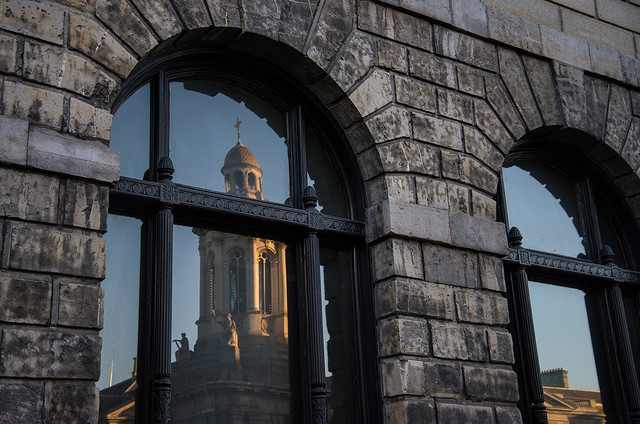It is a crucial time for Trinity’s campus. With the redevelopment of Oisín House, the construction of the new business school and the successful referendum on the introduction of a student levy to build a new student centre, the campus is on the brink of a radical transformation. Decisions made now could affect Trinity and its students for years to come.
One man who will be helping make those difficult decisions is Paul Roberts, director and co-founder of Turnberry Consulting. Turnberry, with Roberts’s assistance, is currently advising the College on their Estates Strategy. That strategy will govern how the College goes about maintaining and redeveloping its campus and estate and will have major ramifications for both students and staff.
Dealing with such a complicated challenge requires efficiency and expertise. Speaking to The University Times, Roberts doesn’t give the impression that he is lacking in either. Before any questions can be asked he wants to know what the exact purpose of the interview is. Throughout the conversation he seems to be continuously thinking in terms of objectives and outcomes. His experience and knowledge of his subject soon becomes apparent. A chartered surveyor and a chartered town planner by profession, Roberts has a wealth of experience in working with universities. “Twenty years ago, I started looking at universities because they are the largest complex estates”, he explains. “I was very fortunate to work with the University of Oxford from 1996 through to 2012 as a consultant. Through that I learned a lot about how universities operate, about complex universities and how they make progress.”
So how do universities like Trinity make progress, and why are estate strategies important in bringing about this progress? The answer, according to Roberts, lies in the ever-changing nature of the university environment. “Universities have been around for a long time”, he notes. “The first acknowledged university was Bologna, founded in 1088, and at that time it was usually a few scholars teaching in a house”, he continues.
“Universities developed estates to be competitive and to control the right teaching environment for their staff and students, and they’ve grown generally quite organically over a very long period of time.”
“You have complex structures of residences, recreation, pastoral care, teaching. Then you get medical sciences, laboratories and you get more complex issues. It’s an area of buildings which are at the forefront of technology so it’s constantly changing.”
Given the dynamism over a very long period of time, if you don’t have an effective and flexible estate strategy then you’ll run into problems
It’s for this reason Roberts believes that estate strategies are so important. “Given the dynamism over a very long period of time, if you don’t have an effective and flexible estate strategy then you’ll run into problems”, he says.
In some cases, these problems can be quite extreme. “Oxford built a nuclear accelerator which is now redundant. So, what do you do with a redundant nuclear accelerator?”
The challenges facing Trinity may be more mundane than defunct nuclear accelerators but the College’s location and history can make any redevelopment on the campus a complex task. “The cost of maintaining a historic estate is difficult”, says Roberts. “It doesn’t matter whether it’s a church or a museum or whatever. It’s harder to maintain a historic estate than anything else. There are disability access issues with these estates which are challenging, which the university has to try and deal with.”
Roberts thinks that the key to adapting Trinity’s older spaces and buildings is in understanding the history that makes them special: “You have to know why its historic. There are buildings on this campus which are nothing like they were when they were built. But you would look at that today and say ‘That’s old, that’s always been like that’.”
“Buildings evolve and you need to understand why they were built and how they’re going to respond to the needs of the future.”
Despite the challenges it poses, Roberts lists Trinity’s historic campus as its greatest strength. “Trinity has probably the most unique set of academic buildings of any capital city in the world. The nature of the scale is monumental, but still appropriate to study in. That’s remarkable.”
Roberts explains that Trinity is so different because of its unique history. It was built at a time in which very few universities were being founded in Britain and Ireland: “It was very unusual that Trinity was founded in 1592, when there were no other (apart from Oxford and Cambridge) English universities, the Scottish ones were very stable and the European ones on a different model, nonresidential, and growing in a different way.”
It is also unusual because it was built based on the same “residential” model as early British universities, as opposed to the simply academic model preferred by European universities at the time. Unlike those universities, however, it only has one college. Oxford, built using the same residential model, has 38. This means that effectively the entire university is contained within that one college: “By Oxbridge standards it’s a very, very large college which means the monumental nature of its structure is much bigger. [Trinity] is very unusual in how it was created and what it is today.”
Trinity has probably the most unique set of academic buildings of any capital city in the world
Trinity may have an unusual university architecture, but Roberts thinks it’s one that can have huge benefits for students. “The first piece of research that was done, at the end of 2016, about the impact of graduation rates and retention rates for different types of universities was very interesting”, notes Roberts. He goes on to explain that “what it discovered was that universities that were urban, green and residential, across the world, tended to be more successful”.
So, universities like Trinity which is very urban, there are not many more urban universities, [which are also] green and residential, which means it’s probably one of the most favoured types of university there is to have the best graduation and retention rates anywhere in the world”.
What does Roberts think is the best way to maximise the huge potential that he clearly sees in Trinity’s campus? “It should celebrate the remarkable history and the nature of the buildings that it has, be progressive and forward thinking and be very careful to use what it has as efficiently as possible because the central campus in Dublin is precious and we want to make it as efficient as possible without over developing it”, he explains. “You have to get that balance right of efficiency alongside protecting the remarkable history.”
Recently, the decision was taken to put the construction of a new student centre to a referendum of the student body and, while Roberts does believe that these spaces are important, he also acknowledges that these spaces are more difficult to create in Trinity’s crowded campus. “I think that over time you have to balance the historic nature of the campus with the ability to try and more creatively identify how you create these student spaces”, he says. “I think they’re really important and they can be created, but they’re not straightforward to achieve at a university like Trinity.”
The student centre will cost about €7 million, while the budget for the new business school is €82.5 million. At a time when funding for third-level institutions is so low, why should universities like Trinity invest so much in managing and developing their estates? Roberts notes that “you still have to be competitive” when it comes to attracting students. “In a situation where you have a historic estate and you have to be competitive with less money than other countries might provide through government, you have to be more thoughtful and more careful about estate strategy”, he says. “This university which is spending a lot of time thinking about its estate, is doing the right thing to ensure that it does remain competitive. It’s very easy when you have lots and lots of money to build lots of things but where you don’t have lots of money you have to be very careful and that’s what it’s doing now.”
Roberts is aware of the scale of the challenge that the university faces in maintaining and improving its estate. His experience in working for Oxford means that he knows better than most the problems that historic campuses can pose. That experience, however, also means that he understands the potential of those campuses and he seems genuinely enthusiastic about the future of Trinity, its campus and the students who will study here. “The rich history of Trinity is a remarkable thing. It has possibly one of the most remarkable group of academic buildings in the world”, he says. “With that remarkable nature comes a degree of inflexibility but I still think there are good opportunities for Trinity to evolve and develop in a way that will create an exceptional environment for students for a long time.”







